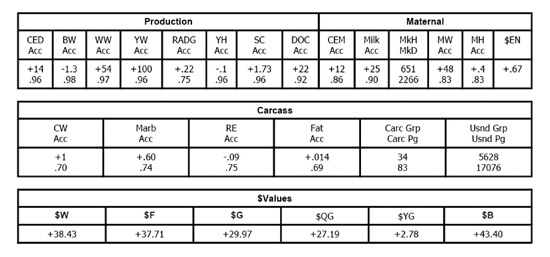Association Perspective
Angus feed efficiency selection tool: RADG
Feed consumption has long been recognized as one of the most important factors in determining profitability of beef cattle production. For many years, producers and the scientific community have attempted to accumulate individual feed intake data in enough volume to allow for genetic selection of more efficient animals. Most of these past efforts involved small numbers of animals and were limited in how the data could be applied. More recently, technology has improved with development of feed intake measuring systems that readily allow for collection of individual feed consumption data on large groups of animals.
The study of feed consumption and its relationship to efficiency has recently been a research priority of the American Angus Association and the Angus Foundation. Research includes multiyear projects at the University of Illinois, North Carolina State University, and Iowa State University that have provided a great foundation of feed intake data for genetic evaluation purposes.
In addition, data from cooperating breeders and bull test facilities contribute substantially to the Angus feed intake database. A statistical protocol implementing a genetic evaluation of feed intake was developed using these data in conjunction with other traits already analyzed in the Angus evaluation system.
Input from breeders motivated expression of results from the feed intake evaluation as an efficiency measure. Thus, residual average daily gain (RADG) is the latest selection tool created for Angus breeders and provided as a regular part of the American Angus Association's suite of expected progeny differences (EPDs).
The initial steps to generate the components needed to calculate RADG include a comprehensive genetic evaluation of multiple phenotypic traits, with the additional inclusion of genomic results from the Angus-specific Igenity profile derived from a high-density whole-genome scan with 50,000 markers (HD WGS). Traits include calf weaning weight, postweaning gain, ultrasound subcutaneous fat thickness, individual calf dry-matter intake, and dry-matter intake genomic values. The weight, gain, fat and genomic pieces function as indicator traits to predict genetic feed intake values.
The resulting feed intake EPD from the genetic analysis is used to calculate residual gain. In this step, the genetic feed intake EPD and the genetic ultrasound fat EPD (a small composition adjustment) are used to adjust the postweaning gain EPD — thus, residual gain (RADG) is created. Weighting factors or regression coefficients, representing genetic trait relationships are used to adjust the intake and fat EPDs in the math.
The genetic correlation between the genomic value and the phenotypic dry-matter intake is 0.45, accounting for 20% of the additive genetic variance. These genomic values function as an indicator trait for dry-matter intake. A similar scenario occurs with indicator traits of ultrasound and genomic values in the carcass EPD model.
RADG is presented in pounds (lb.) per day, with a higher value being more favorable. The range on the initial EPDs was about 0.6 lb. per day genetically, between the most negative and most positive RADG EPD in 2,315 Angus sires that were initially reviewed.
Example
Fig. 1: Bull comparison |
||||
Bull A |
Bull B |
|||
RADG +0.22 .75 |
RADG -0.09 .75 |
|||
| On the average, calves sired by Bull A will have a 0.31 lb.-per-day advantage in average daily gain than calves sired by Bull B when fed the same amount of feed during the postweaning phase. |
||||
In Fig. 1, assume two Angus sires have RADG EPDs of 0.22 and -0.09, respectively. On the average, we would expect calves out of the two sires, when fed the same amount of feed, to have an average daily gain difference of 0.31 lb. per day in the postweaning phase. Again, RADG EPDs characterize genetic differences in gain, given a constant amount of feed.
EPD layout
RADG is reported in pounds per day, or average daily gain, reflective of the postweaning period. It is not a cow efficiency tool.
RADG is reported with other production growth traits. Fig. 2 illustrates the trait presentation in the EPD Pedigree lookup page on www.angus.org.
Additional background
Research reported at the 2010 Beef Improvement Federation (BIF) in Columbia, Mo. (MacNeil, 2010) detailed the Angus genetic evaluation of feed intake and subsequent calculation of residual gain as a measure of feed efficiency. As traits used to calculate residual gain, feed intake and associated indicator traits are moderately heritable, in the estimate range of 0.31 to 0.41. Indicator trait weaning weight accounts for selection bias, by including weaning contemporaries of the calves with intake data. Weaning weight is also correlated to feed intake in the order of 0.41, and a similar relationship exists with postweaning gain and intake. In addition, genomic profile results for intake allow calves to be included in the evaluation and ultimately have an RADG EPD prediction, as a result of the incorporation of DNA technology.
Fig. 2: EPD pedigree lookup display of RADG at www.angus.org |
 |
Economic importance of RADG

Use of the RADG EPD allows producers to characterize Angus genetics that will perform more efficiently in a postweaning feeding environment. It provides a balanced approach to identify cattle that, with a given quantity of feed, will still perform at industry acceptable levels. Leveraging the individual intake data and the genomic information on dry-matter intake in a weekly genetic evaluation will give Angus producers nearly "real time" selection of more feed efficient genetics.
[Click here to go to the top of the page.]





